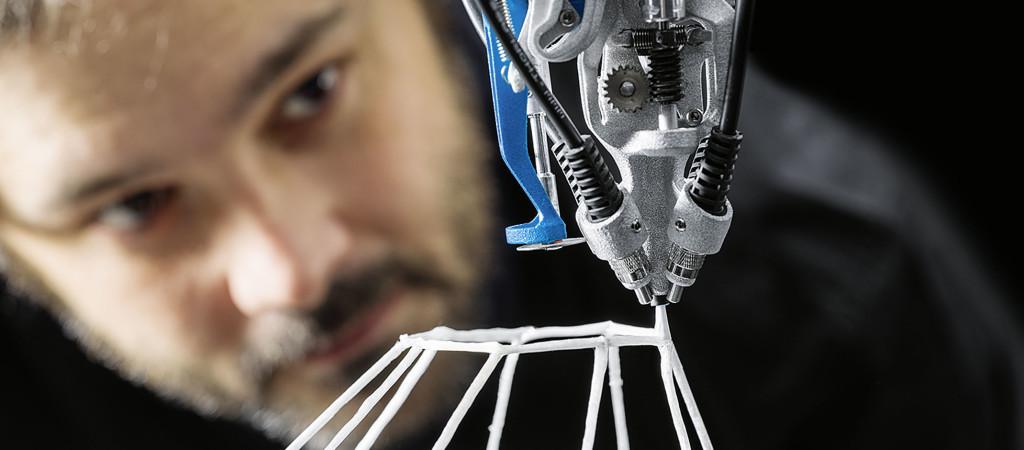 There simply couldn’t be better symbolism in the coupling of the cocoon and 3D printing. We all know about this wonder of nature, which generally begins as fascination when we are young. These tiny caterpillars must survive five rather challenging phases with their cocoons often left to the elements, as they work toward emerging as a butterfly. The cocoon represents a miraculous journey toward transformation and a new aesthetic—much as 3D printing has certainly represented for the world of industry, and continues to go through an array of new phases, amazing us on nearly a daily basis.
There simply couldn’t be better symbolism in the coupling of the cocoon and 3D printing. We all know about this wonder of nature, which generally begins as fascination when we are young. These tiny caterpillars must survive five rather challenging phases with their cocoons often left to the elements, as they work toward emerging as a butterfly. The cocoon represents a miraculous journey toward transformation and a new aesthetic—much as 3D printing has certainly represented for the world of industry, and continues to go through an array of new phases, amazing us on nearly a daily basis.
Now, German company Festo is reawakening the realm of robotics with what may definitely prove to be a transformative new technology by way of the 3D Cocooner. While many of the most impressive technological and scientific breakthroughs throughout history have been based on inspiration from nature, Festo is committed to the study of nature for producing innovation, and the Cocooner is their latest in a series, to debut at the Hannover Fair in Germany, where again this year they will have a unique presence from April 25-29.
 Their work has evolved impressively, centered around the nature motif, as we’ve followed from BionicANTS to eMotion Butterflies. Festo has certainly carved out one niche in their work, specializing in highly functional electronics that network as a team with clear tasks, serving as a parallel for factory and manufacturing work—and displaying the potential for artificial intelligence with nature translated into technology.
Their work has evolved impressively, centered around the nature motif, as we’ve followed from BionicANTS to eMotion Butterflies. Festo has certainly carved out one niche in their work, specializing in highly functional electronics that network as a team with clear tasks, serving as a parallel for factory and manufacturing work—and displaying the potential for artificial intelligence with nature translated into technology.
This latest machine is undeniably mesmerizing. Not only that, it defies tradition even further in terms of a technological rebirth, eschewing what has come to be known as conventional 3D printing with the use of layers—and instead printing from the air itself, recalling the exercise of insects spinning cocoons. The 3D structures are erected via the tripod robot, directed to make a spinneret shape out of fiberglass resin.
“The tripod receives the necessary positional data and control signals directly from an animation software program, in which the 3D shape model parametrically generates the desired structure,” states the Festo team on their website.
The filaments are woven into an intricate lattice work with a network of connected materials that can also be cut and reattached to other areas of the structure as it is in progress.
“Just like a caterpillar, it spins filigree figures and customized lightweight structures from a fiberglass thread,” explains Dr. Elias Knubben, Festo’s head of corporate bionic projects. “The spinneret is precisely controlled by means of a handling system. As soon as they leave the spinneret, the sticky fiberglass threads are laminated with UV hardening resin and are joined together to form complex structures.”
Because the structures are being created in space, the designer can make large designs that are both extremely complex and stable—and do so quickly. The 3D printed ‘threads’ can also be redirected at any point, allowing the user to work within a 3D space, without the inconvenience of supports.
While they are currently being shown in a more basic state, the creators see further potential for the structures as they can be covered in a variety of different materials such as fabrics or foil and can serve in an enclosed state. The current version extrudes material at 10mm per second, operating at a volume of 450 x 300 x 600 mm. The design shape model and the entire system are stored within the software program, allowing for the entire process to be calculated, simulated, and then carried out without any other intermediary steps. As the creators point out, this allows for a direct path from design to production—exemplifying customized manufacturing.
“This is something quite special,” says Dr. Knubben.
What do you think of these amazing robots? Discuss over in the 3D Cocooners forum over at 3DPB.com.
[Source: Drives & Controls]Subscribe to Our Email Newsletter
Stay up-to-date on all the latest news from the 3D printing industry and receive information and offers from third party vendors.
Print Services
Upload your 3D Models and get them printed quickly and efficiently.
You May Also Like
Johns Hopkins University Researchers Develop HyFAM Technology
Two scientists from Johns Hopkins University, Nathan C. Brown and Jochen Mueller, have developed a hybrid manufacturing technology they call HyFam, or Hybrid Formative Additive Manufacturing. Their work on this technology...
3D Printing G-Code Gets an Upgrade: T-Code
Good old G-Code still manages many 3D printers, great and small. Just like the STL, it’s a standard that enables collaboration while also holding the additive manufacturing (AM) industry back....
AM Rewind: The Biggest News and Trends of 2024
After a sluggish 2023, driven by persistent inflation and geopolitical tensions, 2024 has seen some recovery. Economic growth climbed from about 2.8 percent in 2023 to a modest 3.2 percent...
Metal Wire 3D Printer OEM ValCUN Announces Plans for 2025 Expansion
ValCUN, a Belgian original equipment manufacturer (OEM) of wire-based metal additive manufacturing (AM) hardware, has announced that the company has entered the next phase of its growth trajectory, making key...


































